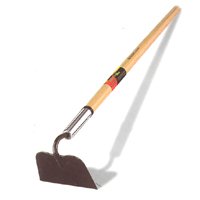The Mash Hoe


Above are pictures of a garden
hoe and a white thermoplastic (or high molecular density plastic) cutting board.
Imagine bolting the cutting board to the blade on the garden hoe. That's the basic
idea behind the mash hoe.
I've seen a lot of breweries on my trip so far. Larger breweries normally have rakes that push out the spent grain. Brewpub brewers generally use a mash hoe, a garden hoe, a shovel or a canoe paddle (might as well use a teaspoon).
I recommend the mash hoe. You can make your own by bolting a piece of cutting board to a standard garden hoe. Cut the cutting board to about 8 x 10 inches, or just smaller than your mash tun side-manway door. (The grain-out door.) You need to be able to push the mash hoe in and out quickly through that door.
Or you can go fancy and have your stainless tank manufacturer make you a mash hoe. Make sure they use 1-inch tubing for the handle and not 1.5-inch tubing. The larger tubing is harder to grip. If they use a solid piece of 1-inch stainless, the handle could become heavy. One advantage of the custom mash hoe is that you can make the handle length as long as you need to reach to the far side of your mash tun.
A garden hoe alone is somewhat efficent. However, the mash hoe's increased surface area allows for faster spent grain removal, and the plastic blade will protect your V-wire or slot screens against the dents, scratches, and rust that a metal garden hoe-blade will cause.
Try a mash hoe. You'll love the difference it makes.
